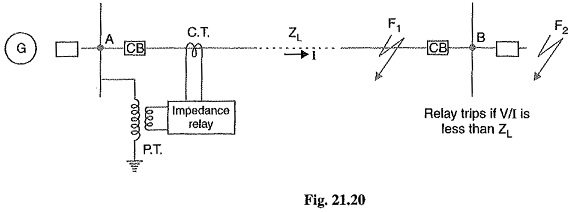Distance Relays or Impedance Relays:
The operation of the relays discussed so far depended upon the magnitude of current or power in the protected circuit. However, there is another group of relays in which the operation is governed by the ratio of applied voltage to current in the protected circuit. Such relays are called Distance Relays or Impedance Relays. In an impedance relay, the torque produced by a current element is opposed by the torque produced by a voltage element. The relay will operate when the ratio V/I is less than a predetermined value.
Fig. 21.20 illustrates the basic principle of operation of an impedance relay. The voltage element of the relay is excited through a potential transformer (P.T.) from the line to be protected. The current element of the relay is excited from a current transformer (C.T.) in series with the line. The portion AB of the line is the protected zone.. Under normal operating conditions, the impedance of the protected zone is Z L. The relay is so designed that it closes its contacts whenever impedance of the protected section falls below the pre-determined value i.e.Z L in this case.
Now suppose a fault occurs at point F1 in the protected zone. The impedance Z (=*V/I) between the point where the relay is installed and the point of fault will be less than Z L and hence the relay operates. Should the fault occur beyond the protected zone (say point F2), the impedance Z will be greater than ZL and the relay does not operate.
Types of Distance Relays or Impedance Relays:
A distance or impedance relay is essentially an ohmmeter and operates whenever the impedance of the protected zone falls below a pre-determined value. There are two types of distance relays in use for the protection of power supply, namely ;
- Definite-Distance relay which operates instantaneously for fault up to a pre-determined distance from the relay.
- Time-Distance relay in which the time of operation is proportional to the distance of fault from the relay point. A fault nearer to the relay will operate it earlier than a fault farther away from the relay.
It may be added here that the distance relays are produced by modifying either of two types of basic relays; the balance beam or the induction disc.
